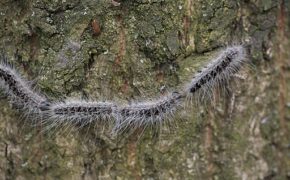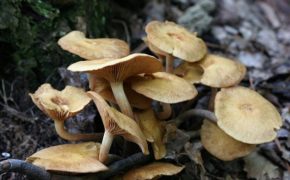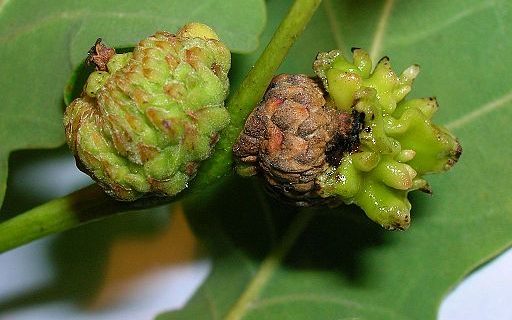
Get a quick no obligation quote It’s free and will only take a jiffy!
What are Oak Galls and How to Stop Them?
If you have noticed strange looking growths on your oak tree and are wondering what’s caused them and what to do about them, read on. The likelihood is that these growths are caused by the oak gall wasp, and there are many different types to look out for.
Odd looking growths on leaves, acorns, stems and flowers of oak trees are usually caused by gall wasps. Oak galls are common. They appear as a result of wasps laying eggs on the various parts of the tree. The wasps inject a hormone into the plant tissue, making it grow abnormally around the larvae to protect it until it hatches. Whilst these galls don’t usually cause major harm to the tree, significant infestations can pose a problem. The good news is that you can get rid of oak galls quite easily. But first, let’s take a look at the different types of gall that you might find.
It is estimated that there are in the region of 133,000 gall-causing insect species worldwide, including gall wasps. Galls vary in shape and size, yet they are created for the same purpose of benefiting the gall wasp or other insect. The tree receives no benefit from the gall, so it is known as a parasitic relationship. The good news is though that the tree’s health generally won’t be affected, although if its acorns are targeted then future crops could be threatened. This won’t impact upon the future of the oak tree however, as there tend to be more acorns than galls, and the galls don’t appear every year.
It’s mainly the native common (Quercus robur) and sessile (Quercus petraea) oak species that are affected by the oak gall wasp, and it’s usually anywhere between March and October that the effects are seen. The trees are the host plants for over 30 species of gall wasps.
Oak galls – what to look out for
Different species of gall wasp form inside the gall structures. The structures are harmless, but do tend to cause concern, especially when they are mistaken for scale insects. Let’s take a look at some of the most commonly found oak galls:
Oak apple gall
The oak apple gall wasp (Biorhiza pallida), one of the most well-known, produces flattened, rounded galls that measure up to 40mm in diameter. The wasp lays its eggs inside a dormant leaf bud which hatches in the spring, so starting the process for the formation of the gall. The galls are spongy in texture and browny-pinky-white, taking on the appearance of small apples. Some fall from the trees around June once the larvae reach maturity. Others stay on the tree and turn into very woody structures.
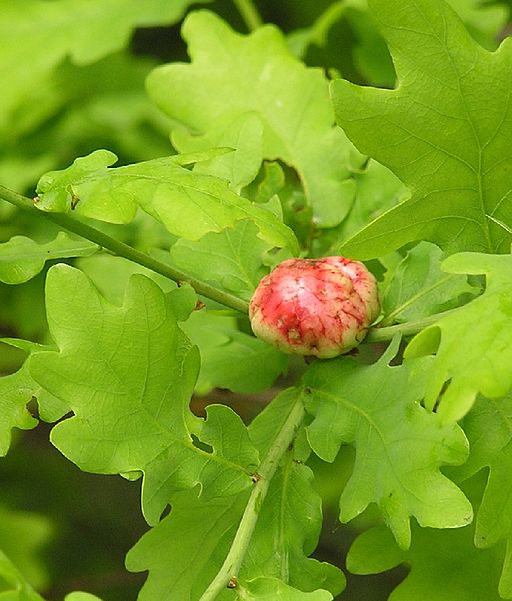
Oak marble gall
The oak marble gall is caused by the Andricus kollari wasp and is found on common oaks. The wasp was actually introduced intentionally in the 1800s for its high tannin content, useful for leather tanning and cloth dying. Look out for small dimples on the surface. Inside, the wasp larvae are sheltered from the elements thanks to the woody outer shell, and those tannins.
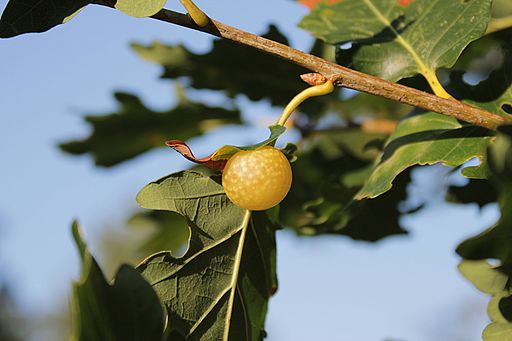
Oak knopper gall
The Andricus quercuscalicis wasp arrived on British shores in the 1950s. It is found primarily on common oaks in England and Wales. The wasp lays its eggs on the newly pollinated oak flowers, with the offspring deforming the acorn to serve its own means. The knopper gall develops over the summer, then falls to the ground in the autumn once the larvae emerge.
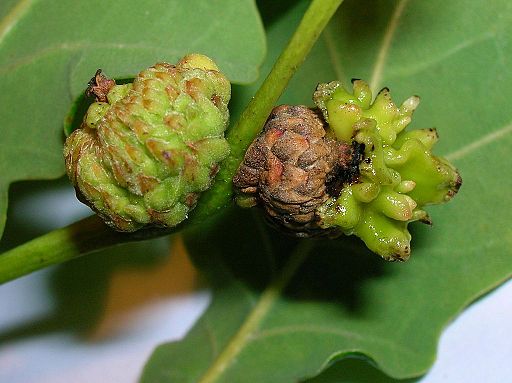
Oak spangle gall
There are actually four different types of oak spangle gall found UK wide, the creations of four variants of gall wasps. They all look very similar, although on very close inspection you will see a range of surface structures amongst them. The oak spangle gall targets both native oak species, and some other non-native species too. You’ll see the falls in spring when the wasps lay their eggs on the newly emerged leaves. The larvae emerge during the summer months.
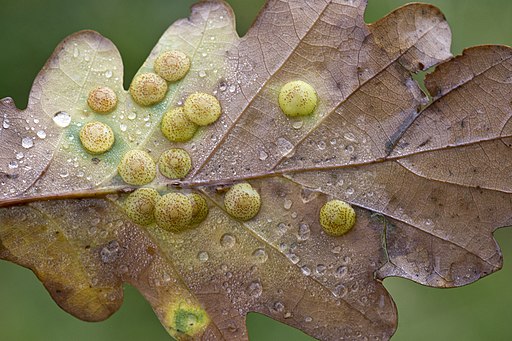
Oak artichoke gall
The Andricus fecundator wasp lays its eggs in the buds that form at the tips of the shoots. These grow unusually large over the summer, then the following spring the next generation form small, hairy pale brown or green galls on the male catkins.
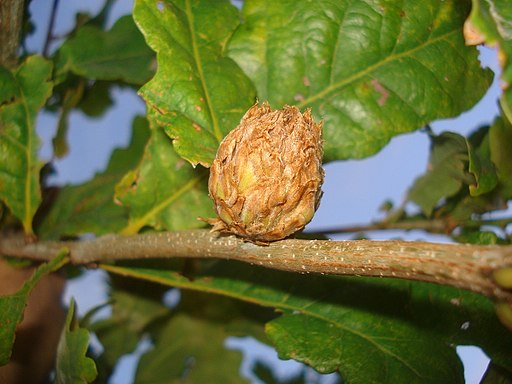
Silk button gall
Silk button galls are formed by the Neuroterus numismalis wasp. They are small in size, around just 3mm in diameter, and golden brown in colour with a pronounced central depression. These galls develop on the underside of oak leaves in late summer to early autumn, with the next generation forming small oval galls on the male catkins and leaf margins the following spring.
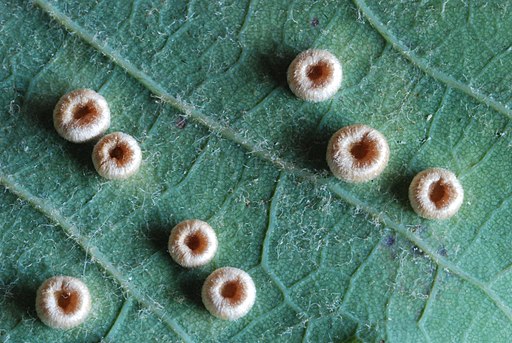
Oak cherry gall
The Cynips quercusfolii wasp forms rounded pithy galls up to 20mm in diameter on the underside of oak leaves during late summer to autumn. Yellowish-green or red in colour, the galls tend to remain attached to fallen leaves.
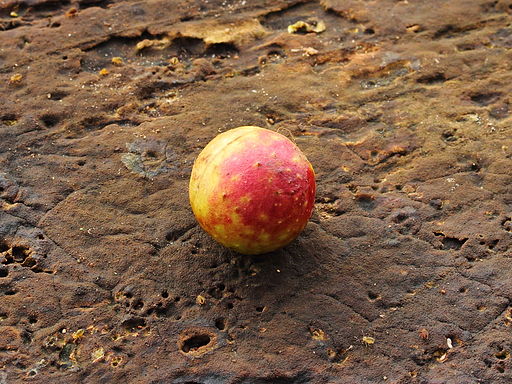
How to control oak galls
Oak gall wasps don’t really have any impact on a tree’s health. Because growth tends to be minimal, control is not usually necessary. You can usually live with a minor infestation without issue.
However, it is useful to note that unhealthy or stressed oak trees can be more prone to suffer from gall damage than heathier ones. Keeping your tree healthy through good watering, fertilising, mulching and pruning may help keep gall wasps at bay.
It is also good practice to take up fallen leaves and twigs quickly to prevent the spread of oak tree disease. Gall producing insects are known to overwinter in fallen debris.
Lastly, you can help to reduce the gall-producing insect population by hanging bird feeders in your oak trees. Birds are natural predators of the various species of gall wasps and will help keep them at bay.
Expert Help with Tree Care
When it comes to the health of your oak trees, expert advice will always be of benefit. If you are concerned about insect infestation within your common or sessile oak trees, whether caused by a gall wasp or other insect, you are welcome to contact our helpful specialists for individual advice.
At T.H. Tree Services we have been taking care of trees for over 15 years. For a free consultation and friendly advice, please give us a call on 01268 642814.
Amazing service from Mark and his team. We had a problem with Bamboo that had spread from a neighbours garden. Mark kept us informed with regular phone calls and images of how the work was progressing, as we were not present the house. 1st class job and a pleasure to do business with this company.
Thank you Colin and Gillian for your kind review. It was a pleasure to be able to clear the bamboo for you.

